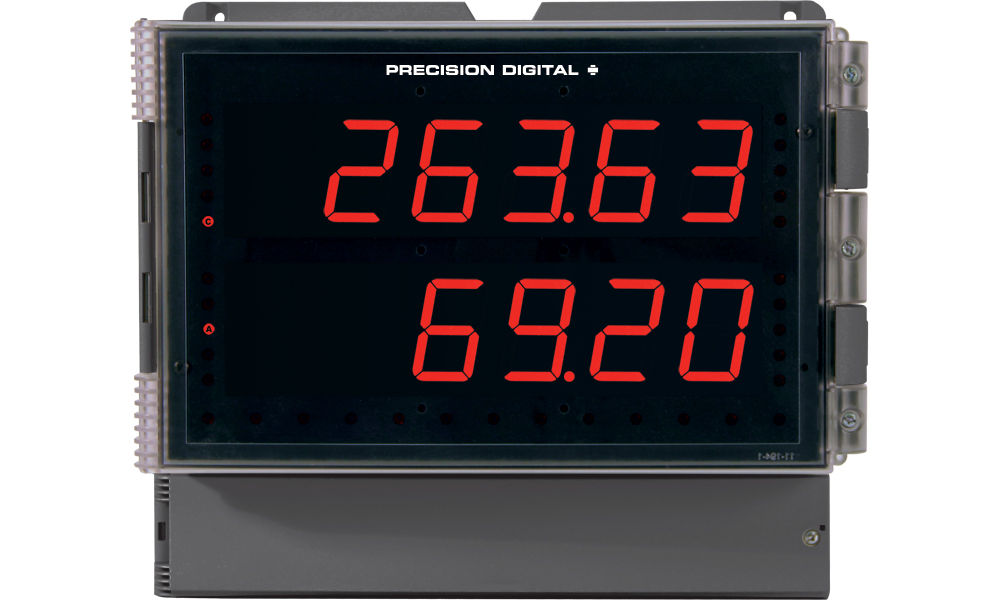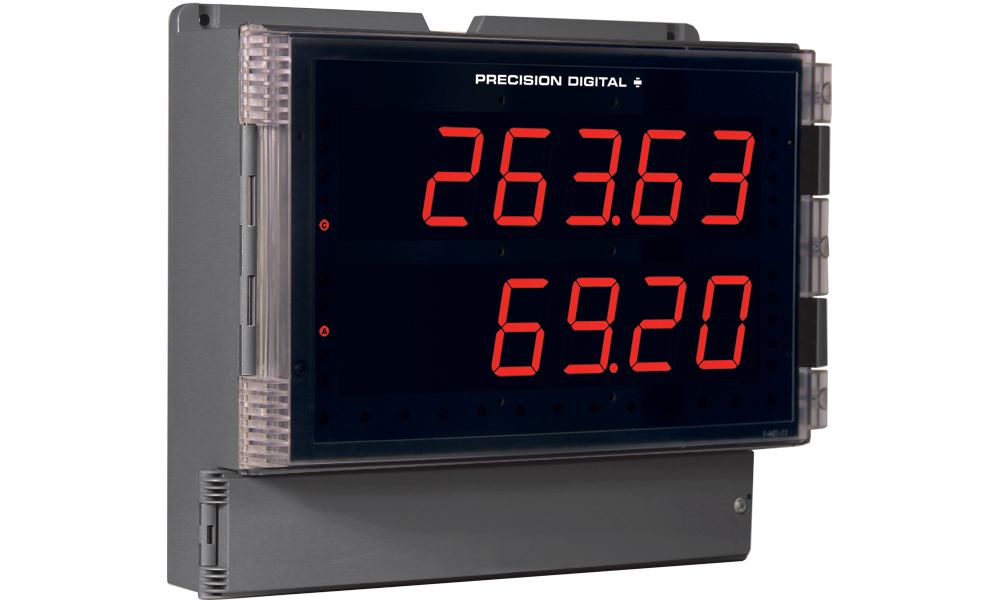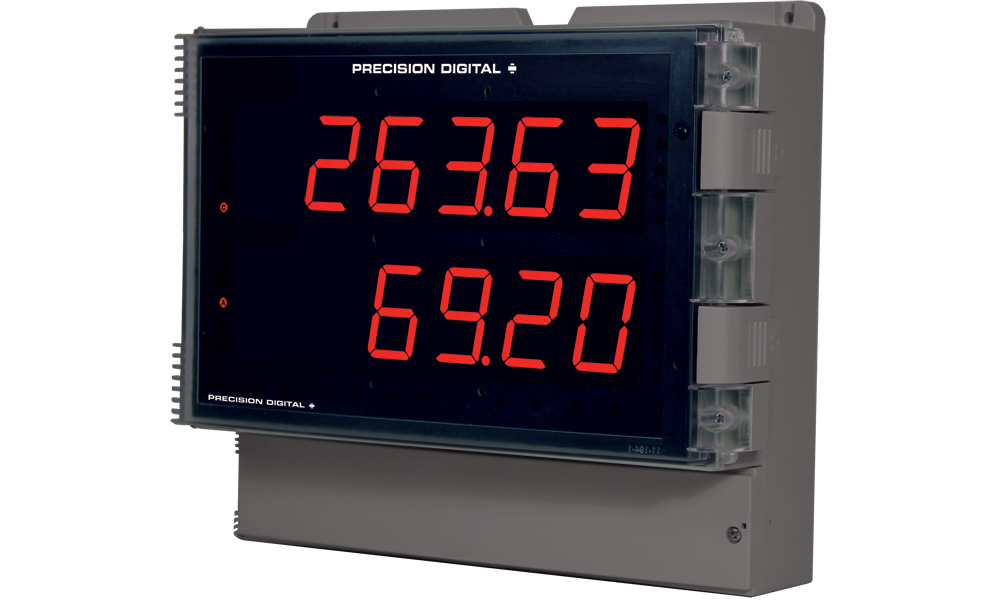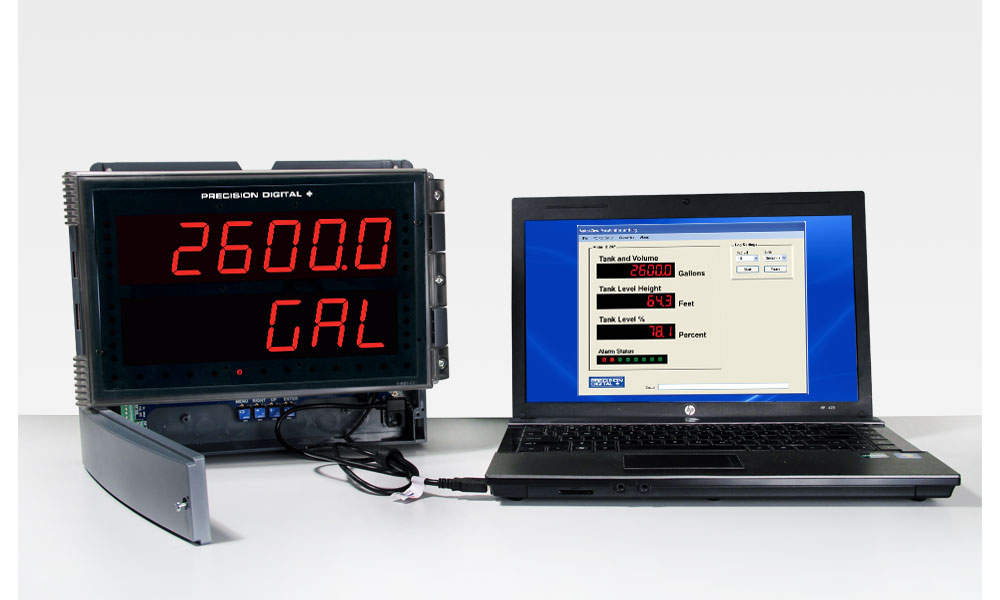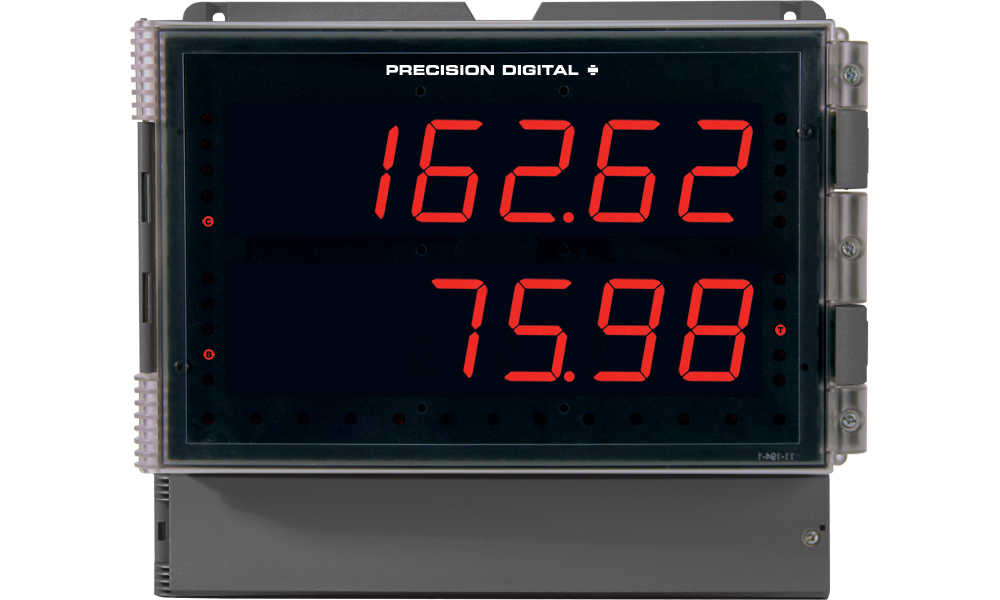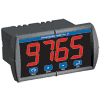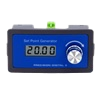Except where noted all specifications apply to operation at +25°C.
General
Display: Two lines with 1.8" (46 mm) high digits, red LEDs; 6 digits per line (-99999 to 999999), with lead zero blanking
Display Intensity Eight user selectable intensity levels
Display Update Rate: 5/second (200 ms)
Overrange: Display flashes 999999
Underrange: Display flashes -99999
Display Assignment: The Upper and Lower displays may be assigned to show:
- One or more rate channels: Channel A (Ch-A), B (Ch-B), or C (Ch-C)
- Toggle between rate channels: Ch-A & Ch-B, Ch-A & Ch-C, Ch-B & Ch-C, and Ch-A, Ch-B, & Ch-C
- Total or grand total: Ch-A or Ch-B
- Rate and total or grand total: Ch-A, Ch-B
- Relay set points
- Max and/or min values: Ch-A, Ch-B, or Ch-C
- Toggle between any rate channel & units
- Total and units: Ch-A or Ch-B
- Toggle between totals: Ch-A & Ch-B; Ch-A, Ch-B, and sum of Ch-A and Ch-B
- Modbus input
The lower display may also be set to show engineering units or be off, with no display.
Programming Methods: Four programming buttons, digital inputs, PC and MeterView Pro software, or Modbus registers.
Noise Filter: Programmable from 2 to 199 (0 will disable filter)
Filter Bypass: Programmable from 0.1 to 99.9% of calibrated span
Recalibration: All ranges are calibrated at the factory. Recalibration is recommended at least every 12 months.
Max/Min Display: Max/min readings reached by the process are stored until reset by the user or until power to the meter is turned off.
Password: Three programmable passwords restrict modification of programmed settings.
Pass 1: Allows use of function keys and digital inputs
Pass 2: Allows use of function keys, digital inputs and editing set/reset points
Pass 3: Restricts all programming, function keys, and digital inputs.
Power Options: 85-265 VAC 50/60 Hz, 90-265 VDC, 20 W max or 12-24 VDC ± 10%, 15 W max. Powered over USB for configuration only.
Isolated Transmitter Power Supply: Terminals P+ & P-: 24 VDC ± 10%. 12-24 VDC powered models selectable for 24, 10, or 5 VDC supply (internal P+/P- switch). 85-265 VAC models rated @ 200 mA max, 12-24 VDC powered models rated @ 100 mA max, @ 50 mA max for 5 or 10 VDC supply.
Non-Volatile Memory: All programmed settings are stored in non-volatile memory for a minimum of ten years if power is lost.
Fuse: Required external fuse: UL Recognized, 5 A max, slow blow; up to 6 meters may share one 5 A fuse
Normal Mode Rejection: Greater than 60 dB at 50/60 Hz
Isolation: 4 kV input/output-to-power line; 500 V input-to-output or output-to-P+ supply
Overvoltage Category: Installation Overvoltage Category II: Local level with smaller transient overvoltages than Installation Overvoltage Category III.
Environmental: Operating temperature range: -40 to 150°F (-40 to 65°C); Storage temperature range: -40 to 185°F (-40 to 85°C); Relative humidity: 0 to 90% non-condensing
Connections: Removable and integrated screw terminal blocks accept 12 to 22 AWG wire.
Enclosure: UL Type 4X, IP65 rated. Polycarbonate & glass blended plastic case, color: gray. Includes four PG11 through-hole conduit openings, with two factory installed PG11, IP68, black nylon threaded hole plugs with backing nuts.
Wall Mounting: Four (4) mounting holes provided for mounting meter to wall.
Pipe Mounting: Optional pipe mounting kit (PDA6260) allows for pipe mounting. Sold separately.
See PD2-6363 manual for instructions.Tightening Torque: Removable Screw Terminals: 5 lb-in (0.56 Nm);
Digital I/O and RS485 Terminals: 2.2 lb-in (0.25 Nm)
Overall Dimensions: 10.63" x 12.59" x 4.77" (270 mm x 319.7 mm x 121.2 mm) (H x W x D)
Weight: 6.10 lbs (2.76 kg)
UL File Number: UL & C-UL Listed. E160849; 508 Industrial Control Equipment.
Warranty: 3 years parts & labor
USB Connection: Compatibility: USB 2.0 Standard, Compliant
Connector Type: Micro-B receptacle
Cable: USB A Male to Micro-B Cable
Driver: Windows 98/SE, ME, 2000, Server 2003/2008, XP 32/64-Bit, Vista 32/64-Bit, Windows 7 32/64-Bit, Windows 10 32/64-Bit
Power: USB Port
Dual Process Input
Two Inputs: Field selectable: Pulse or square wave 0-5 V, 0-12 V, or 0 24 V @ 30 kHz; TTL; open collector 4.7 kΩ pull-up to 5 V @ 30 kHz; NPN or PNP transistor, switch contact 4.7 kΩ pull-up to 5 V @ 40 Hz; Modbus PV (Slave)
Channels: Channel A, Channel B, Channel C (Math channel)
Math Functions:| Name | Function | Setting |
| Addition | (A+B+P)*F | Sunm |
| Difference | (A-B+P)*F | diF |
| Absolute diff. | ((Abs(A-B))+P)*F | diFAbS |
| Average | (((A+B)/2)+P)*F | AvG |
| Multiplication | ((A*B)+P)*F | nmulti |
| Division | ((A/B)+P)*F | divide |
| Max of A or B | ((AB-Hi)+P)*F | Hi-Ab |
| Min of A or B | ((AB-Lo)+P)*F | Lo-Ab |
| Draw | ((A/B)-1)*F | drAuw |
| Weighted avg. | ((B-A)*F)+A | uw avg |
| Ratio | (A/B)*F | ratio |
| Concentration | (A/(A+B))*F | Concen |
| Total Addition | (tA+tB+P)*F | Sunm t |
| G. Tot. Addition | (GtA+GtB+P)*F | SunmGT |
| Total Difference | (tA-tB+P)*F | Dif t |
| G. Tot. Difference | (GtA-GtB+P)*F | Dif GT |
| Total Ratio | (tA/tB)*F | Tratio |
| Total Percent | (tA/(tA+tB))*100 | T PCT |
Note: The F constant can be any value from 0.001 to 999.999. If the value is less than 1, it will have the same effect as a divider. For example, the average could also be derived by using (A+B)*F, where F = 0.500.Sequence Of Operations For Input Programming:- Select Input for A and B
- Set up the rate, total, and grand total engineering units for channels A & B, and units for math channel C
- Set up rate, total, and grand total decimal points for channels A & B, and decimal point for math channel C
- Program channel A & B rate parameters
- Program channel A & B total and reset parameters
- Set up the display line 1 and line 2
- Select the transfer function for A & B (e.g. Linear)
- Select Math function for Channel C
- Program constants for Factor (F) and Adder (P).
- Program cutoff values for A and B
Programmable Constants: Constant P (Adder): -99.999 to 999.999, default: 0.000;
Constant F (Factor): 0.001 to 999.999, default: 1.000
Low Voltage Mag Pickup: Sensitivity: 40 mVp-p to 8Vp-p
Minimum Input Frequency:0.001 Hz. Minimum frequency is dependent on high gate setting.
Maximum Input Frequency:30,000 Hz (10,000 for low voltage mag pickup)
Input Impedance:Pulse input: Greater than 300 kΩ @ 1 kHz.
Open collector/switch input: 4.7 kΩ pull-up to 5 V.
Accuracy: ±0.03% of calibrated span ±1 count
Temperature Drift: Rate display is not affected by changes in temperature.
Multi-Point Linearization 2 to 32 points for channel A and B
Low-Flow Cutoff:0-999999 (0 disables cutoff function)
Decimal Point: Up to five decimal places or none: d.ddddd, d.dddd, d.ddd, d.dd, d.d, or dddddd
Calibration:May be calibrated using K-factor, internal calibration, or by applying an external calibration signal.
K-Factor: Field programmable K-factor converts input pulses to rate in engineering units. May be programmed from 0.00001 to 999,999 pulses/unit.
Calibration Range: Input 1 signal may be set anywhere in the range of the meter; input 2 signal may be set anywhere above or below input 1 setting. Minimum input span between any two inputs is 10 Hz. An error message will appear if the input span is too small.
Filter: Programmable contact de-bounce filter: 40 to 999 Hz maximum input frequency allowed with low speed filter.
Time Base: Second, minute, hour, or day
Gate: Low gate: 0.1-99.9 seconds, High gate: 2.0-999.9 seconds
F4 Digital Input Contacts: 3.3 VDC on contact. Connect normally open contacts across F4 to COM.
F4 Digital Input Logic Levels: Logic High: 3 to 5 VDC, Logic Low: 0 to 1.25 VDC
Dual Rate/Totalizer
Rate Display Indication: -99999 to 999999, lead zero blanking.
Total Display & Total Overflow: 0 to 999,999; automatic lead zero blanking. Up to 999,999,999 with total-overflow feature. "oF" is displayed to the left of total overflow and ▲ LED is illuminated.
Total Decimal Points: Up to five decimal places or none: d.ddddd, d.dddd, d.ddd, d.dd, d.d, or dddddd. Total decimal point is independent of rate decimal point. Channel A and B decimal points programmed independently.
Dual Totalizer: Calculates total for channels A and B based on rate and field programmable multiplier to display total in engineering units. Time base must be selected according to the time units in which the rate is displayed. Channel A and B totalizer parameters programmed independently.
Totalizer Rollover: Totalizer rolls over when display exceeds 999,999,999. Relay status reflects display.
Total Overflow Override: Program total A or B total reset for automatic with 0.1 second delay and set point 1 for 999,999
Totalizer Alarm Presets:Up to eight, user selectable under setup menu. Any set point can be assigned to channel A or B total or grand total (or C) and may be programmed anywhere in the range of the meter for total alarm indication.
Total & Grand Total Reset: Via front panel button, external contact closure on digital inputs, automatically via user selectable preset value and time delay, or through serial communications. Channel A and B total and grand total reset parameters programmed independently.
Total Reset Password: Total and grand total passwords may be entered to prevent resetting the totals or grand totals from the front panel.
Non-Resettable Total: The grand totals can be programmed as non-resettable totals by entering the password "050873". Both channels are set to non-resettable when this password is entered.
CAUTION! Once the Grand Totals have been programmed as "non-resettable" the feature
cannot be disabled.
Programmable Delay On Release: 0.1 and 999.9 seconds; applied to the first relay assigned to total or grand total.
If the meter is programmed to reset total to zero automatically when the preset is reached, then a delay will occur before the total is reset.
Relays
Rating: 2 or 4 SPDT (Form C) internal and/or 4 SPST (Form A) external; rated 3 A @ 30 VDC and 125/250 VAC resistive load; 1/14 HP (≈ 50 W) @ 125/250 VAC for inductive loads
Noise Suppression: Noise suppression is recommended for each relay contact switching inductive loads. See manual for details.
Deadband: 0-100% of span, user programmable
High Or Low Alarm: User may program any alarm for high or low trip point. Unused alarm LEDs and relays may be disabled (turn off).
Relay Operation: Automatic (non-latching) and/or manual reset; Latching (requires manual acknowledge) with/without clear; Pump alternation control (2 to 4 relays); Sampling (based on time); Off (disable unused relays and enable Interlock feature); Manual on/off control mode
Relay Reset: User selectable via front panel buttons or digital inputs
- Automatic reset only (non-latching), when the input passes the reset point.
- Automatic + manual reset at any time (non-latching)
- Manual reset only, at any time (latching)
- Manual reset only after alarm condition has cleared (latching)
Note: Front panel button or digital input may be assigned to acknowledge relays programmed for manual reset.Time Delay: 0 to 999.9 seconds, on & off relay time delays; Programmable and independent for each relay
Fail-Safe Operation: Programmable and independent for each relay.
Note: Relay coil is energized in non-alarm condition. In case of power failure, relay will go to alarm state.Auto Initialization: When power is applied to the meter, relays will reflect the state of the input to the meter.
Isolated 4-20 mA Transmitter Output
Output Source: Process variable (PV), max, min, set points 1-4, Modbus input, or manual control mode
Scaling Range: 1.000 to 23.000 mA for any display range
Calibration: Factory calibrated: 4.000 to 20.000 = 4-20 mA output
Analog Out Programming: 23.000 mA maximum for all parameters: Overrange, underrange, max, min, and break
Accuracy: ± 0.1% of span ± 0.004 mA
Temperature Drift: 0.4 μA/°C max from 0 to 65°C ambient, 0.8 μA/°C max from -40 to 0°C ambient
Note: Analog output drift is separate from input drift.Isolated Transmitter Power Supply: Terminals I+ & R: 24 VDC ± 10%. Isolated from the input at >500 V. May be used to power the 4-20 mA output or other devices. All models rated @ 40 mA max.
External Loop Power Supply: 35 VDC maximum
Output Loop Resistance:| Power supply | Minimum | Maximum |
| 24 VDC | 10 Ω | 700 Ω |
| 35 VDC (external) | 100 Ω | 1200 Ω |
RS485 Serial Communications Terminal
Compatibility: EIA-485
Connectors: Removable screw terminal connector
Max Distance: 3,937' (1,200 m) max
Status Indication: Separate LEDs for Power (P), Transmit (TX), and Receive (RX)
Modbus® RTU Serial Communications Protocol
Slave: ID 1 – 247 (Meter address)
Baud Rate: 300 – 19,200 bps
Transmit Time Delay: Programmable between 0 and 199 ms
Data: 8 bit (1 start bit, 1 or 2 stop bits)
Parity: Even, Odd, or None with 1 or 2 stop bits
Byte-To-Byte Timeout: 0.01 – 2.54 second
Turn Around Delay: Less than 2 ms (fixed)
Note: Refer to the Modbus Register Tables located at www.predig.com for details.Digital Input & Output Terminal
Channels: 4 digital inputs & 4 digital outputs
Digital Input Logic High: 3 to 5 VDC
Digital Input Logic Low: 0 to 1.25 VDC
Digital Output Logic High: 3.1 to 3.3 VDC
Digital Output Logic Low: 0 to 0.4 VDC
Source Current: 10 mA maximum output current
Sink Current: 1.5 mA minimum input current
+5 V Terminal: To be used as pull-up for digital inputs only. Connect normally open pushbuttons across +5 V & DI 1-4.
WARNING! DO NOT use +5 V terminal to power external devices.
